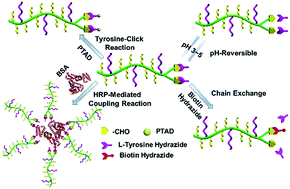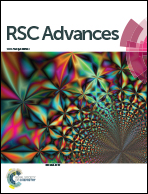Environmentally responsive amino acid-bioconjugated dynamic covalent copolymer as a versatile scaffold for conjugation†
Abstract
Biodynamers display the properties of biomolecules with the adaptive nature of dynamic covalent polymers and have great potential as “smart” materials. The bioconjugation of L-tyrosine hydrazide to the end of bisaldehyde-functionalized thermoresponsive copolymer chains via reversible acylhydrazone linkage generated a biodynamer with thermo/pH-responsive and adaptive features. Because of the introduction of amino acid end groups, the biodynamer had an isoelectric point (IEP) at pH 4.70 and possessed a pH-dependent LCST. The properties of the biodynamer were tunable through chain exchange reactions with other hydrazine or hydrazide molecules. The biodynamer endowed biological recognition by exchange with biotin hydrazide. The complex formed by the biotinylated dynamer and streptavidin demonstrated pH-responsive features. Because of the versatile reactivity of the phenolic moiety, this biodynamer provided a reactive scaffold for further modification. The cyclic diazodicarboxamide was attached to the biodynamer through the tyrosine-click reaction. Protein bioconjugate with pH-responsive and adaptive features was prepared via HRP-catalyzed coupling reaction.


 Please wait while we load your content...
Please wait while we load your content...